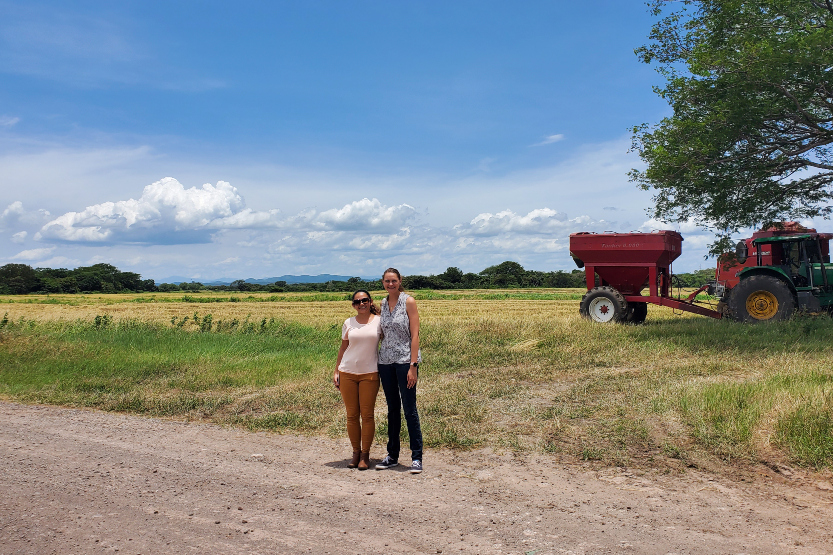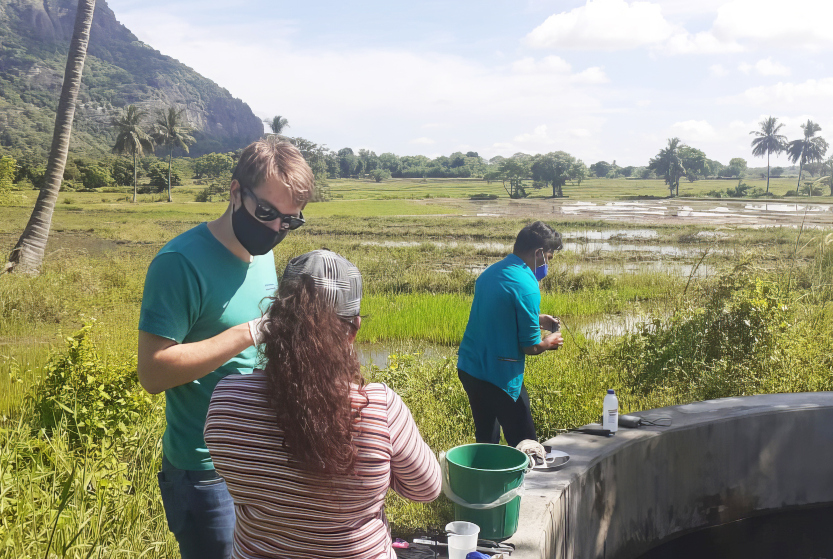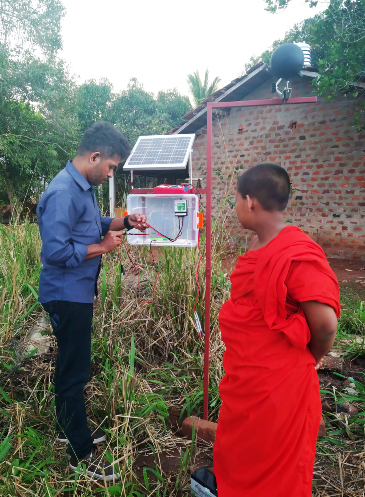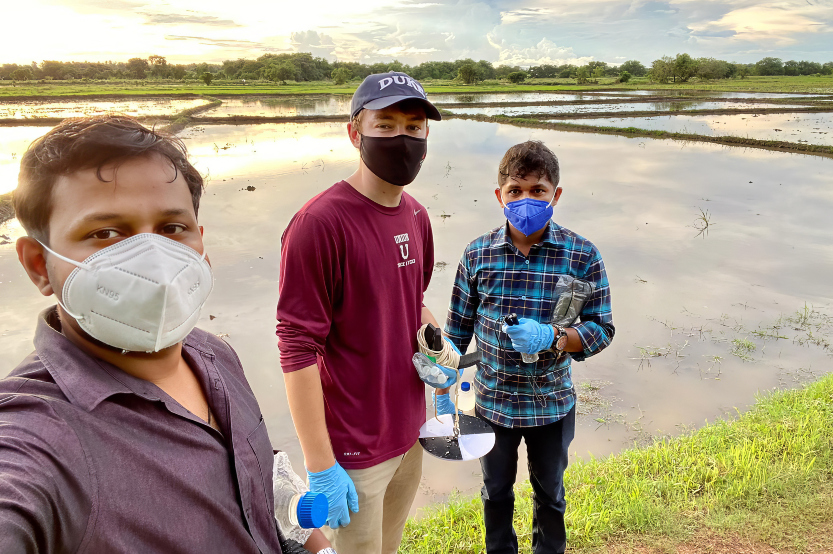
A Rising Tide of Kidney Disease in Rural Communities
Kidney disease is typically linked to conditions like diabetes and high blood pressure, which gradually wear down the kidneys’ delicate systems that keep the body in balance.
But the communities that Duke University researchers Nishad Jayasundara , PhD, and nephrologist Anna Strasma , MD, study are facing a different problem.
“What we’re seeing is a rise in kidney disease in communities with no other major risk factors,” said Jayasundara, the Juli Plant Grainger assistant professor of global environmental health at the Nicholas School of the Environment. “Perfectly healthy, able-bodied men who’ve worked in hot, dry conditions for years suddenly show up at the hospital with stage-four kidney failure.”
Since the 1990s, the epidemic of chronic kidney disease has been unfolding in farming and agricultural communities – most notably in Sri Lanka, India, and Central America. Often without warning or explanation, agricultural workers, particularly men in their 30s and 40s, are succumbing to chronic kidney disease.
Work is underway to look at whether agricultural workers in North Carolina, who harvest crops like tobacco, Christmas trees and sweet potatoes, might be at risk too.

This unexplained form of kidney failure is now the second leading cause of death in Nicaragua where men frequently work in rice fields or cut sugarcane. In some parts of the country, 1 in 3 men has end-stage kidney disease, also known as renal failure.
What makes the condition called chronic kidney disease of unknown cause (CKDu) so alarming is that it seems to disproportionately target those who toil long hours farming in extreme heat. Heat stress can harm the kidneys in several ways, including reducing their oxygen supply as the body tries to cool down and triggering inflammation.
While researchers scramble to understand the root cause, one thing is clear: climate change is exacerbating the crisis. Rising temperatures, extreme heat events, and unpredictable weather patterns are making it harder for workers to protect themselves.
Hidden Health Hazard
For the third time this year, Jayasundara is in Sri Lanka where more than 20,000 people have end-stage renal disease. A reported 60% of the people in the community of Uddanam in India have kidney failure.
In Sri Lanka, he gathers data on heat from both satellites and monitors worn by agricultural workers to better understand the connection between climate change and chronic kidney disease.
But it’s not just heat that’s to blame. His research points to a disturbing link between agricultural practices and the rise of kidney disease. Farmers often use agrochemicals, which, when combined with extreme heat may be creating the perfect storm for kidney damage.
“If I were to predict who has kidney failure in these communities, I can best predict it based on how well-built their house is,” said Jayasundara, a faculty member at the Duke Global Health Institute. “Poverty is the common denominator.” The poorest laborers, lacking air conditioning and proper shelter from the heat, are the most exposed to intense heat stress as well as a high burden of chemical contaminants -- both in their homes and at work.
Jayasundara is part of the Environmental Exposures and Kidney Health group, a broad initiative of experts from Duke University, Duke University School of Medicine, the National Institute of Environmental Health Sciences (NIEHS), and the University of North Carolina at Chapel Hill who have been working to understand the exact causes of CKDu and how climate change plays a role.
They want to learn more about the interplay of the environment and kidney outcomes.

One of their studies focuses on salt pan workers who labor in unforgiving sun, harvesting salt in vast fields of evaporating seawater. “They are breaking salt in shallow pools,” Jayasundara said. “It’s hard labor, and because their exposure to agrochemicals are much less, we’re trying to determine if heat alone can explain kidney injury in this group.”
The challenges are immense. Accurate heat monitoring and environmental data collection have proven difficult, with satellite data often underestimating temperature extremes in rural areas.
“The extremes are where the problem lies when you think about health outcomes,” Jayasundara said. One of the most pressing concerns is the impact on children.
“We’re already seeing signs of kidney injury in kids,” he said. “If the damage begins that early, it means these children have been exposed to harmful conditions for much of their young lives.”
Answers For All of Us
To round out the work happening in the field, nephrologists Christina Wyatt , MD, Jason Watts , MD, PhD, a Duke-affiliated nephrologist based with the NIEHS, and Mary Helen Foster, MD, are investigating environmental exposures and kidney health.
Foster, who conducts lab research on glomerulonephritis, a kidney disease where the immune system mistakenly attacks the kidneys, has developed specialized models to better understand CKDu and is turning her attention to heat-stressed renal failure.
Heat illness symptoms often show up when the body temperature nears 104 degrees Fahrenheit, especially when the humidity is above 70%. In high humidity, sweating doesn’t cool the body as well, causing the core body temperature to climb.
Excessive heat can lead to heavy sweating, reducing blood flow to the kidneys and causing significant fluid loss. This volume loss and dehydration can impair kidney function, making it harder for the kidneys to do their job.
“But what’s happening with chronic recurrent heat exposure? We don’t know very much,” she said. “As a discipline we study acute heat stroke, but we’ve barely scratched the surface of what long-term, repeated heat exposure does to the body.”
Studies by the livestock, poultry and fish industries highlight the impact of heat on biological systems, showing reduced growth, poor reproduction, and lower food production. “The agricultural industry has been studying this for years because it hits their bottom line, but we haven’t applied that same focus to human health.”

In communities affected by CKDu, like those in Sri Lanka, researchers think that a mix of environmental toxins and heat is causing the problem. One big concern is silica dust.
“Silica is a major concern in crops like rice and sugarcane, especially when these plants are burned, converting silica to its toxic crystalline form,” Foster said.
Breathing in this dust can cause lung inflammation, which then affects other parts of the body, including the kidneys.
The connection between environmental hazards and kidney disease has long intrigued researchers, and for Strasma, an assistant professor of medicine and affiliate of the Duke Global Health Institute, the journey began as a kid during frequent trips to Central America with her parents and a Christian nonprofit.
“It was there that I first encountered kidney disease,” she said of a bus ride past protesters raising the alarm about the dangers faced by agricultural workers.
Now she researches kidney disease with local collaborators in Costa Rica who coordinate focus groups and interviews with affected communities. The stories are heartbreaking.
“Christmases are really sad here because there’s no dads around anymore,” Strasma recalled a community member telling her.
It’s a community known for its sugarcane production, where workers endure long hours under scorching sun, cutting cane in fields recently burned for harvest. “They’re walking into fields that are 105 degrees, still hot from the burn, and chopping with machetes,” Strasma said.
The condition remains a mystery, even as it claims more lives. “People know their stages—‘I’m stage three, my neighbor’s on dialysis.’ The disease is that widespread,” Strasma explained.
While heat exposure is a clear risk factor, Strasma, a kidney specialist, believes the causes are multifactorial. “There have always been hot places with outdoor labor, but this is different,” she explained. Other potential causes include exposure to agrochemicals, heavy metals in drinking water, and even possible genetic factors.

One of the biggest challenges is diagnosing the disease early. Symptoms don’t typically appear until the kidneys are already severely damaged. Unlike kidney disease caused by diabetes or hypertension, there are no proven treatments to slow the progression of CKDu.
For the workers, it’s a no-win situation. “They know they’re probably going to get kidney disease, but they have to feed their families, so they just keep going,” Strasma said.
While education and self-care measures like staying hydrated and resting in the shade can help, Strasma stresses the need for systemic changes. There is no federal standard protecting workers from heat, with some states taking steps, but North Carolina remains without such measures.
For the Nicholas School of the Environment researcher, the next phase of research, starting next year, will be spent behind the computer, analyzing years worth of data to look for answers.
“We have to think globally to protect these communities, and ultimately, to help all of us,” Jayasundara said.
Shantell M. Kirkendoll is a senior writer and managing editor in the Office of Strategic Communications.
Photography by Eamon Queeney who is assistant director of multimedia and creative in the Office of Strategic Communications.
